
Starksia cremnobates, the fugitive blenny, is a species of labrisomid blenny endemic to the Gulf of California where it is found at depths of around 60 metres (200 ft).

Starksia culebrae or culebra blenny is a species of labrisomid blenny native the waters around the Caribbean islands of the Antilles.

Starksia fasciata, the blackbar blenny, is a fish species of labrisomid blenny so far known only from around the Bahamas and Cuba. It inhabits shallow, rocky areas at depths of from 6 to 7 meters. This species can reach a length of 2.7 centimetres (1.1 in) SL.

Starksia fulva, known commonly as the yellow blenny, is a species of labrisomid blenny native to the Pacific coast of the Americas from Costa Rica to Ecuador. It is found in shallow weedy or sandy habitats at depths of from 1 to 3 m. This species can reach a length of 4.5 cm (1.8 in) TL.

Starksia galapagensis, the Galapagos blenny, is a species of labrisomid blenny endemic to the Galapagos Islands. It inhabits rocky reefs with plentiful weed-growth at depths of from 3 to 25 m. This species can reach a length of 4.5 cm (1.8 in) TL.

Starksia guttata, the spotted blenny, is a species of labrisomid blenny native to the Caribbean Sea and the Atlantic Ocean from the Grenadines to Curaçao and Trinidad. This species is a reef inhabitant. It can reach a length of 4.6 cm (1.8 in) SL.
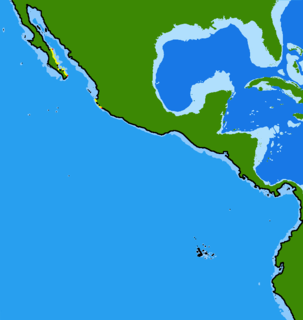
Starksia hoesei, the hose blenny, is a species of labrisomid blenny native to the eastern Pacific Ocean and the Gulf of California where it is known to occur at depths of from 24 to 32 m. The specific name honours the ichthyologist Douglass F. Hoese of the Australian Museum in Sydney.

Starksia lepicoelia, known commonly as the blackcheek blenny, is a species of labrisomid blenny native to the Caribbean Sea and adjacent Atlantic Ocean. It inhabits coral reefs and can be found at depths of from 8 to 20 m. This species can reach a length of 3.4 cm (1.3 in) TL.

Starksia lepidogaster, the scalybelly blenny, is a species of labrisomid blenny endemic to the Tres Marias Islands off the Pacific coast of Mexico. It can be found from very shallow waters to a depth of 13 m (43 ft).

Starksia posthon, the brown-spotted blenny, is a species of labrisomid blenny native to the Pacific coast of Central America from Costa Rica to Panama. It inhabits sandy areas with weed growth in shallow waters. This species can reach a length of 4 cm (1.6 in) TL.

Starksia rava, the tawny blenny, is a species of labrisomid blenny endemic to the waters around the island of Tobago. It is found inhabiting reefs at depths of from 6 to 11 metres. This species can reach a length of 2.5 centimetres (0.98 in) SL.
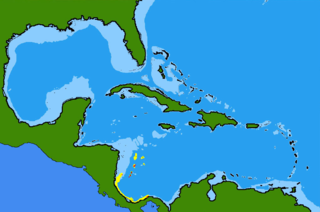
Starksia robertsoni, the Robertson's blenny, is a species of labrisomid blenny native to the Caribbean coast of Panama. It was previously known as Starksia lepicoelia, and is also closely related to Starksia weigti and Starksia williamsi. It is named after D. Ross Robertson, a scientist from Smithsonian Institution. Males of this species can reach a length of 2.1 cm (0.83 in) SL while females are slightly larger at 2.2 cm (0.87 in).

Starksia sangreyae, the Sangrey's blenny, is a species of labrisomid blenny native to the Caribbean coasts of Belize and probably also Honduras where it is found in shallow waters at depths of from 1 to 2 m. It was originally known as Starksia atlantica, and is also closely related to Starksia springeri. The species is named after Mary Sangrey, a scientist from Smithsonian Institution. This species can reach a length of 1.6 cm (0.63 in) SL.
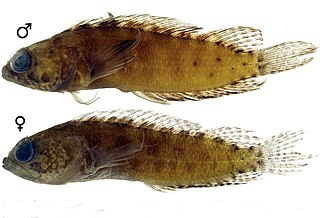
Starksia sella, the darksaddle blenny, is a species of labrisomid blenny endemic to the waters around the island of Tobago. It is an inhabitant of reefs, being found at depths of from 5 to 29 metres. This species can reach a length of 2.9 centimetres (1.1 in) SL.

Starksia spinipenis, the phallic blenny, is a species of labrisomid blenny native to the Pacific coast of Mexico from the Gulf of California to Acapulco. It prefers shallow sandy areas with weed growth. This species can reach a length of 5 centimetres (2.0 in) TL. The specific name is a compound noun if spinis meaning "spine" and penis, a reference to the first spine in the anal fin of the males which is elongated and free of the fin membrane and is modified as a copulatory organ, a characteristic of the genus Starksia.

Starksia springeri, the Springer's blenny, is a species of labrisomid blenny endemic to the waters around Curaçao where it is found at depths of from 1 to 25 m. It was originally known as Starksia atlantica, and is also closely related to Starksia sangreyae. The species is named after Victor G. Springer, a scientist from Smithsonian Institution. Males can reach a length of 1.5 centimetres (0.59 in) SL while females grow to 1.9 cm (0.75 in).
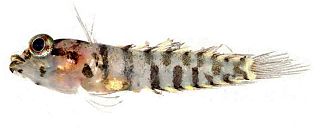
Starksia starcki, the key blenny, is a species of labrisomid blenny native to the Caribbean Sea. It inhabits coral reefs, preferring surge channels at depths of from 6 to 19 m. This species can reach a length of 4 cm (1.6 in) TL. It is also found in the aquarium trade. The specific name honours the Walter A Starck II in recognition of his contributions to marine biology.

Starksia weigti, the Weigt's blenny, is a species of labrisomid blenny known only from the Caribbean coastal waters of Belize at depths of from 6 to 8 metres. It was previously known as Starksia lepicoelia, and is also closely related to Starksia williamsi and Starksia robertsoni. It is named after Lee A. Weigt, head of the Smithsonian's Laboratories of Analytical Biology. Males of this species can reach a length of 2.4 cm (0.94 in) SL While females reach 1.9 cm (0.75 in). >

Starksia williamsi, the Williams's blenny is a species of labrisomid blenny known only from the Saba Bank in the Netherlands Antilles where it occurs at depths of from 15 to 28 m. It was previously known as Starksia lepicoelia, and is also closely related to Starksia weigti and Starksia robertsoni. It was named after Jeffrey T. Williams, a scientist from Smithsonian's National Museum of Natural History known for his work on Starksia. This species can reach a length of 2.1 cm (0.83 in). The specific name honours the ichthyologist Jeffrey T. Williams of the National Museum of Natural History who has worked extensively on the blenniiform fishes.
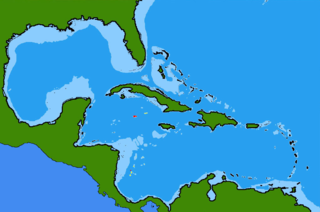
Starksia y-lineata, the forked bar blenny, is a species of labrisomid blenny native to reef environments of the Caribbean Sea. This species can reach a length of 1.9 cm (0.75 in) SL.






















